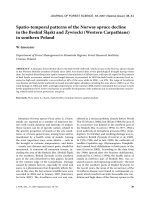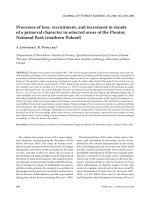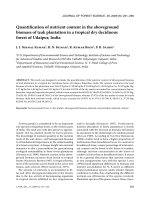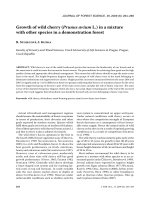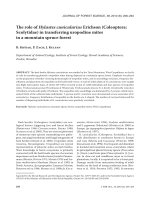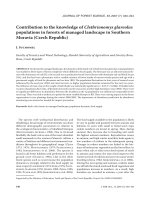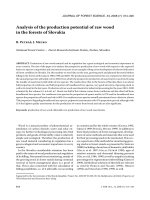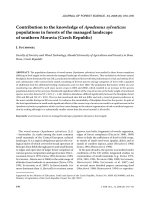Báo cáo lâm nghiệp: " Growth, mineral nutrient content and nitrogen metabo- ism in Laccaria laccata-inoculated and non-inoculated Douglas fir seedlings during their growth period" docx
Bạn đang xem bản rút gọn của tài liệu. Xem và tải ngay bản đầy đủ của tài liệu tại đây (169.33 KB, 4 trang )
Growth,
mineral
nutrient
content
and
nitrogen
metabo-
lism
in
Laccaria
laccata-inoculated
and
non-inoculated
Douglas
fir
seedlings
during
their
growth
period
M.
Chalot,
B. Botton
J. Banvoy
Université
de
Nancy
I,
Facult6
des
Sciences,
Laboratoire
de
Physiologie
Végétale et
Forestibre,
BP 239,
54506
Vandœuvre-Iès-Nancy,
France
Introduction
Enhanced
plant
growth
caused
by
ecto-
mycorrhizal
inoculation
in
the
nursery
is
well
documented:
thus Laccaria
strains
have
proven
to
be
very
efficient
for
im-
proving
growth
of
various
conifers
(Le
Tacon
and
Bouchard,
1986).
The
investi-
gations
described
herein
were
carried
out
to
obtain
information
on
physiological
and
biochemical
modifications
that
can
explain
such
stimulation.
The
present
study
com-
pared
the
seasonal
changes
in
protein
and
amino
acid
levels,
aspartate
amino-
transferase
activity
and
nutrient
content
in
both
L.
laccata-inoculated
and
non-inocu-
lated
Douglas
fir
grown
in
a
forest
nursery.
Materials
and
Methods
After
1
yr
of
growth
in
the
nursery,
12
seedlings
from
both
untreated
and
treated
plots
were
col-
lected
at
random,
bimonthly
from
May
to
Sep-
tember.
Root
and
top
fresh
weights
and
heights
were
measured
for
each
seedling.
Parts
of
the
needles
and
roots
were
removed
immediately
after
collection
for
amino
acid,
protein
and
enzyme
determinations.
Aspartate
aminotrans-
ferase
(AAT)
activity
was
determined
spectro-
photometrically
and
proteins
were
measured
using
a
colorimetric
method.
Amino
acids
were
analyzed
using
an
HPLC
procedure.
Total
N
was
measured
by
a
microKjeldahl
method,
total
P
by
a
colorimetric
method
and
K
and
Mg
by
atomic
absorption
spectrophotometry.
Results
By
the
end
of
the
growing
period,
L.
lac-
cata-inoculated
seedlings
were
significant-
ly
higher
(not
shown)
and
had
accumulat-
ed
more
than
2-fold
the
fresh
matter
of
the
controls
(Table
I).
In
expanding
shoots,
N,
P,
K
and
Mg
concentrations
decreased
rapidly
until
mid-August
(Fig.
1
A,
B,
C,
D)
and
tended
to
increase
after
growth
ceased.
No
significant
difference
was
found
in
nutrient
analysis
of
stems
and
roots
between
treated
and
untreated
plants
(not
shown).
By
contrast,
statistical-
ly
significant
(ANOVA,
P
=
0.05)
changes
were
observed
for
leaf
nutrient
analysis
between
treatments
and,
more
particularly,
by
the
end
of
the
growing
season
(Fig.
1A,
B, C, D).
Concerning
protein
amounts
and
AAT
activity
levels,
high
and
significant
differ-
ences
(ANOVA,
P
=
0.05)
were
found
in
analysis
between
inoculated
seed-
lings
and
controls:
leaves
of
inoculated
Douglas
fir
accumulated
higher
protein
amounts
(Fig.
1 F)
and
showed
greater
AAT
capacities
(Fig.
1 E).
By
contrast,
there
was
no
difference
in
root
analysis
between
treatments
(Fig.
1 E,
F).
Alanine,
aminobutyric
acid,
glutamine,
aspartic
acid,
arginine,
proline
and
glu-
tamic
acid
were
the
major
components
of
the
free
amino
acid
pools
in
root
and
leaf
tissues.
Alanine
and
glutamine
in
both
root
and
leaf
tissues
appeared
to
be
in
higher
amounts
in
L.
laccata-inoculated
Douglas
fir,
whereas
proline
preferentially
accumu-
lated
in
non-inoculated
seedlings
(Table
11).
Discussion
and
Conclusion
Growth
measurements
reaffirmed
the
well-
established
importance
of
L.
laccata
strain
238
for
improving
seedling
growth
of
Douglas
fir
(Le
Tacon
and
Bouchard,
1986).
Leaf
nutrient
content
following
ino-
culation
also
confirmed
the
importance
of
ectomycorrhizae
for
nutrient
uptake,
as
reviewed
by
Harley
(1969).
Our
results
also
suggested
that
inocula-
tions
caused
changes
in
the
biochemical
processes
of
the
host
tissues
as
demon-
strated
earlier
(Nemec
and
Meredith,
1981;
Krishna
and
Bagyara,
1983).
Thus,
alanine,
proline
and
glutamine
contents,
protein
amounts
and
AAT
activity
levels
differed
between
controls
and
treated
plants.
As
a
hypothesis,
we
might
propose
that
lower
AAT
activity
combined
with
a
higher
proline
amount
in
non-inoculated
Douglas
fir
characterized
seedlings
in
stress-induc-
ing
situations.
AAT
is
often
considered
as
an
indicator
of
physiological
activity
in
plants
affected
by
various
internal
or
ex-
ternal
factors
(Cooper
and
Hill-Cofting-
ham,
1974)
and
proline
accumulation
de-
scribed
as
a
response
to
environmental
stress
factors
(Bode
ef al.,
1985).
Inocula-
tion
with
efficient
mycorrhizal
strains
might
provide
a
way
to
suppress
or
at
least
to
attenuate
stress-inducing
situations.
References
Bode
J.,
Kuhn
H.P.
&
Wild
A.
(1985)
The
accu-
mulation
of
proline
in
needles
of
damaged
spruce.
Forstwiss.
Centralbl.
104,
353-360
Cooper
D.R.
&.
Hill-Cottingham
D.G.
(1974)
Glutamic
dehydrogenase
and
glutamic
oxaloa-
cetate
transaminase
in
apple
tree.
Physiol.
Plant.
31, 193-199
Harley
J.L.
(1969)
In:
The
Biology
of
Mycorrhi-
zae.
Leonard
Hill,
London
Krishna
K.R.
&
E3agyara
D.J.
(1983)
Changes
in
the
free
amino
nitrogen
and
protein
fractions
of
groundnut
caused
by
inoculation
with
VA
mycorrhizas.
Ann.
Bot
51,
399-401
Le
Tacon
F.
&
Bouchard
D.
(1986)
Effects
of
dif-
ferent
ectomycorrhizal
fungi
on
growth
of
larch,
Douglas
fir,
Scots
pine
and
Norway
spruce
seedlings
in
fumigated
nursery
soil.
Acta
Oecol.
Appl.
7,
389-402
Nemec
S.
&
Meredith
F.
(1981)
Amino
acid
content
of
leave:>
in
mycorrhizal
and
non
mycor-
rhizal
citrus
root
stocks.
Ann.
Bot.
47, 203-222
